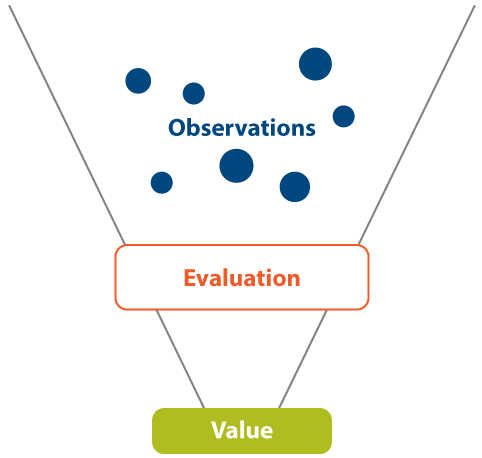The Funneling Technique
By Michael Wilkinson, CMF
Managing Director, Leadership Strategies, Inc.
 Have you heard a client say something like the following?
Have you heard a client say something like the following?
- “It did not work very well”
- “It was the best job ever done”
- “I liked it”
- “He’s not too smart”
Our term for declarations such as these are “evaluation statements.” With evaluation statements, your client is providing you a personal assessment of a person, thing, or situation. While many consultants might accept such a statement at face value, we believe that considerable information can be gained through utilizing a technique we call funneling.
With funneling, anytime you hear an evaluation statement, probe for the observations that support the evaluation to identify the person’s underlying values.
Below is an example of funneling in action.
Client: We had a consultant in last year looking at this same process, but he wasn’t very good. (evaluation statement)
Consultant: Really? What was it that he did or didn’t do that made him not that good? (probe for observations)
Client: He didn’t have a methodology. He never came to a meeting with an agenda. He just seemed to wing it. My boss got frustrated and we didn’t ask him back after the third meeting.
Consultant: Writes note to himself: The Client values organization. Be sure to communicate the overall approach from the start.
In this example, the client made an evaluation statement about the prior consultant. By probing for the observation, the new consultant learned key information about what the client values. The consultant can therefore adjust to better serve the client. But this information may not have been gained if the consultant had accepted the evaluation statement at face value and not used the funnel technique.
Note as well that the same evaluation statement can lead to a different value if the observations are different. Let’s go back to the prior example. Suppose the exchange had been as follows?
Client: We had a consultant in last year looking at this same process, but he wasn’t very good. (evaluation statement)
Consultant: Really? What was it that he did or didn’t do that made him not that good? (probe for observations)
Client: He didn’t have a degree, he never cited any of his sources. He couldn’t back up anything he said with hard data. Not much substance at all. We didn’t ask him back after the third meeting.
Consultant: Writes note to himself: The Client values credentials and documentation. Be sure to indicate the advanced degrees held by staff and to document sources of all information.
In this case, the evaluation statement was the same, but the observations were different. Accordingly, the observations pointed to a different set of values.
Whenever you hear a client give an evaluation statement, be sure to probe for the observations to learn valuable information that can help you serve your client even better.
You can learn more tips on serving clients in our class, The Facilitative Consultant.
Michael Wilkinson is the Managing Director of Leadership Strategies – The Facilitation Company and author of The Facilitative Consultant training course.Prior to Leadership Strategies, he spent eight years with Ernst & Young’s Management Consulting Group. You can get more tips from either of Michael’s books, The Secrets of Facilitation or The Secrets to Masterful Meetings. You can receive a signed copy through our website.

